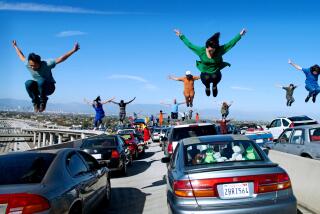Deborah Sussman dies at 83; L.A. designer known for bold use of color
- Share via
Designer Deborah Sussman, whose bold color choices for thousands of 1984 Olympics signs, gateways, pylons, uniforms and venue exteriors were at first controversial but came to define the look of the event in Los Angeles, died at home Tuesday in West Los Angeles. She was 83.
The cause was breast cancer, said her husband, Paul Prejza.
Sussman used her signature combination of bright hues such as magenta and chrome yellow, sometimes mixed with pastels, to create graphics and signage that can be found in buildings and cityscapes worldwide. She also designed for the concert stage, including for a Rolling Stones tour.
One of the last projects in which she was involved was signage for Grand Park, which opened in downtown Los Angeles in 2012. It includes 16-foot-high entrance totems that say in 26 languages, “the park for all.”
She was largely unknown at the time of the Olympics, when her wildly colorful graphics for the event were unveiled. Some critics thought the designs too nondescript.
Sam Hall Kaplan, writing in the Los Angeles Times, called a sample banner “a disappointment. It could very well be representing a trendy Melrose Avenue emporium or a traditional Little Tokyo restaurant.”
But architect Frank Gehry, who worked with Sussman in the early 1960s, said this week that her striking designs seen by millions around the world during the Games were “a home run.”
“That’s what the Olympics were about — to put Los Angeles at the center of attention,” Gehry said. “Deborah put that into a visual.”
Sussman’s choice of magenta, as well as yellow and vermilion, was influenced by a trip to Mexico in the 1950s to help make a documentary film about the Day of the Dead holiday. “Design was so integrated with life in Mexico,” she said in a 1986 New York Times interview. “You’d go into a market and there were hundreds and thousands of things made for those two days.”
She also threw aqua into the mix, “representing the Mediterranean spiritual climate of Los Angeles,” she said in a 1986 Los Angeles Times interview. “And that juxtaposition meant L.A. ’84.”
Because of the overall popularity of her Olympic designs, Sussman — who was a colorful presence herself with her purple-rimmed eyeglasses, bright clothing and accessories that sometimes included a fishing lure as an earring — became primarily known for her color sense. But she didn’t mind.
“There are millions of colors,” she told the Seattle Times in 2003. “Picking the right ones is a challenge I just love.”
Deborah Evelyn Sussman was born in Brooklyn, N.Y., on May 26, 1931. Her father was a newspaper artist who gave her some of her earliest lessons in drawing, and she was known in school for supplementing her reports on historical figures with drawn portraits.
She attended Bard College in upstate New York and the Institute of Design in Chicago. In 1953 she got a summer internship to work with the seminal Los Angeles designers Charles and Ray Eames. Recognizing her talent, the couple asked her to stay on, and she worked for them for several years, designing the look of packaging, posters and other materials.
“Charles Eames convinced her she didn’t need a college degree,” Prejza said. When the Eameses were traveling, Sussman would house-sit at their famed Midcentury Modern home in Pacific Palisades. “That helped her decide she wanted to stay here,” Prejza said.
In the 1960s she designed catalogs for the Los Angeles County Museum of Art and collaborated with Gehry on the interior design of a high-end Joseph Magnin department store in San Jose.
“We invented a model for retail, we thought,” Gehry said. It involved filmed runway shows projected on a wall and graphics that could be changed as new products came into the store. “We would stay up late, talking and agonizing about where things should go. She was an artist, and it was a hell of a collaboration. I’ll never forget it.”
Sussman and Prejza, who is an architect, married in 1972 and combined forces to create Sussman/Prejza & Co. “She was a ball of energy,” said artist Judy Chicago, who made her best-known work, “The Dinner Party,” in a space she rented behind the Sussman/Prejza office.
Even though Sussman often worked in collaboration, she was not always willing to compromise. “She is very intense, often arrogant in her passion, and can be incredibly difficult to work with,” architect Jon Jerde, who was in charge of the overall look of the 1984 Olympics, said in a 1988 Los Angeles Times interview. “But she is always worth the trouble.”
In the years after the Olympics she gained an international clientele that included branding and other projects for companies such as Apple, Disney, Samsung and Southern California Gas. There were also projects for U.S. embassies in Berlin and the Hague, and numerous museums and entertainment and sports venues including UCLA’s Pauley Pavilion and the McCaw Hall opera house in Seattle, for which she used 132 colors.
A retrospective of her work was shown at the WUHO Gallery in Hollywood last year. “All my life, I was a hard worker,” she told the New York Times at the opening of the show. “And I would add that much of the time, I loved what I was working on.”
Outside the gallery, the neon sign announcing the show was tinted magenta.
In addition to her husband, Sussman is survived by her sister, Janet Gartner, of New York.
Twitter @david.colker
More to Read
Start your day right
Sign up for Essential California for the L.A. Times biggest news, features and recommendations in your inbox six days a week.
You may occasionally receive promotional content from the Los Angeles Times.







